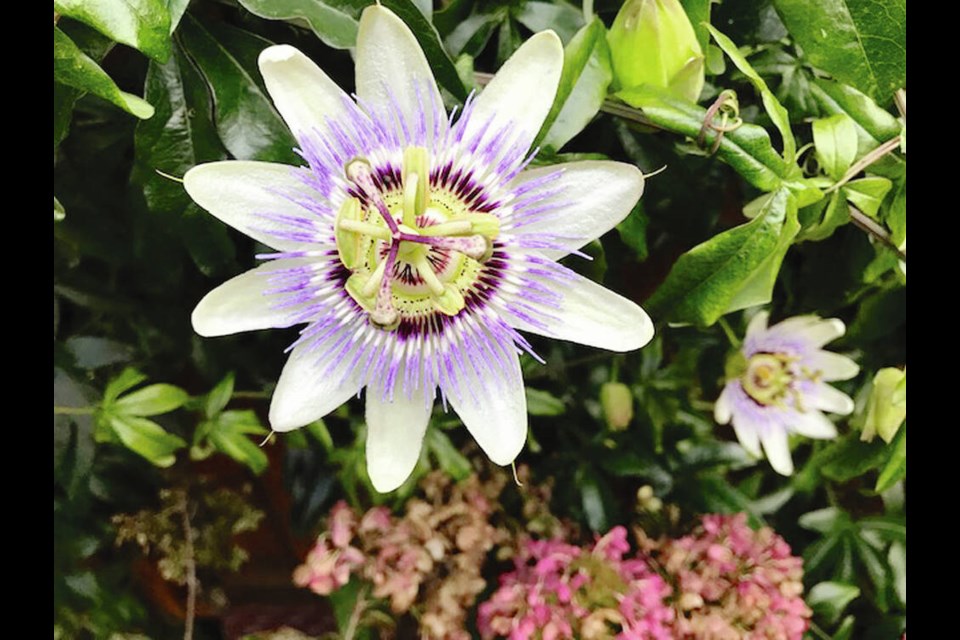Dear Helen: When my passion flower vines bloomed this summer and early autumn, only two blooms were open at any given time. Why?
sa╣·╝╩┤½├Į
Your passion flower, Passiflora caerulea (blue passion flower), has a reputation for being somewhat unpredictable, but there are usually reasons for less than ideal growth and flowering. The vines bloom best in full sun and warmth, and they need a soil kept consistently and adequately moistened but not wet.
Too much water, and/or too much nitrogen in the soil, will inhibit free flowering. An over-balance of nitrogen over phosphorus and potassium in the soil will produce an abundance of lush green growth that bears few flowers. When flowering is sparse, consider a few waterings with a solution of Alaska Morbloom, a fertilizer with no nitrogen. Its formula of 0-10-10 indicates the percentage in that order of nitrogen, phosphorus and potassium.
Pruning can help to promote good flowering. Prune in early spring to remove dead and weak growth and to relieve over-crowding. Shorten stems to keep the vine within bounds. After flowering, cut back shoots that have flowered to within two or three buds of the main (framework) stems.
Dear Helen: The carrot in the attached photo is weird. One carrot with two tops, as though two seedlings started our side by side and then got together underground. No crazy glue was involved. Have you ever seen this? I hadn’t.
M.N.
I’ve never experienced this particular peculiarity in my carrots. What an unusual fusion. Any forking that develops in carrots takes place most often at the roots’ lower ends, usually because of some small obstructions in the soil. Your carrot begins as two and melds into one root below.
I cannot find any research specifically on this particular carrot configuration. I have found one photo similar to yours but not on a website that offers any explanation for it.
One possible reason for the fusion is that the two carrots were bumping up against each other as the roots developed, and the close contact triggered a merging. This is not the usual outcome of crowded carrot roots. A more common result is two roots twisting around each other.
Dear Helen: In the past two years I have lost my entire strawberry crop, despite having wood and plastic netting covers in place to protect the plants. I suspect rats and squirrels, but there are also rabbits in the area. Flowers appear and berries begin developing, but they disappear while they are still green. We have chickens and had developed a big rat problem before my husband made a rat-proof feeder. This barrier has created a population of hungry rats. Have you any suggestions for protecting the strawberries next year, or do I give up?
S.F.
A secure cage made of bird netting or chicken wire placed over a strawberry planting should offer effective protection against feeding by the many rodents that will target strawberries. The netting or wire needs to have holes no bigger than five cm wide.
I’m wondering what difference(s) might exist between the effective chicken feeder protection and the cover over the strawberries. If the two are reasonably comparable, any difference might supply the answer to why rodents are accessing the strawberries.
A cage that can be easily lifted away to care for the strawberries is usually adequate protection, unless the rats or other rodents are burrowing underneath the barrier edges to access the plants. To bar access by burrowing, It is usually recommended, in similar situations, to sink wood or strips of wire fencing 15 cm deep into the ground along the edges where the cage sides will sit
I had a rat visiting my strawberry patch only once. It was quickly dispatched by one of the neighbourhood cats.
I have found that mint-imbued cotton balls have discouraged mice from setting up housekeeping in the garden shed. When I realized how expensive peppermint extract was I switched to soaking the absorbent balls in strongly mint-flavoured mouth wash. Because mice and rats tend to avoid mint odours, some gardeners sink pots of mint around strawberries to repel the rodents. The mint needs to be potted; otherwise it will spread quickly.
Most rat and mice traps are not humane. Snap traps don’t always kill cleanly. Poisoning and glue traps bring a lingering, painful death.



